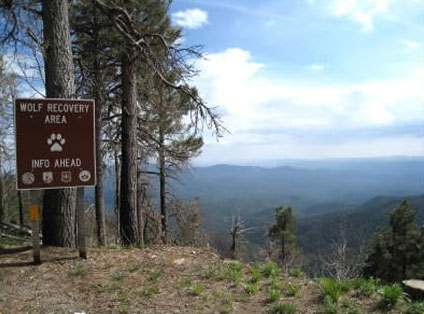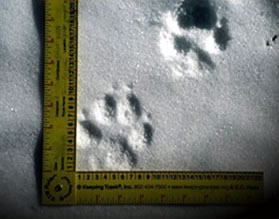
Mexican wolves are rare, so spotting them in the wild isn’t easy. A good way to get familiar with wolves is to check out our photo gallery or video gallery. You can also visit the Albuquerque or Phoenix zoos, or a zoo near you to see Mexican gray wolves in captivity.

Know your wolf from your coyote.
People often confuse coyotes and wolves, but there are some telltale differences between the two. The first is size. A Mexican wolf is nearly twice the size of a coyote. Lobos have a shorter, blockier muzzle than coyotes. Coyotes’ noses are slender and pointed. Mexican wolves’ ears are more rounded, while coyotes’ ears are relatively longer and more pointed. Lobos appear to have long legs and very large feet, when compared with coyotes. Wolves also move differently; they have a smooth, long-legged pacing motion when they trot, while coyotes are more skittish and bounding in their movements, although lobos do “bound” through deep snow. Here is a great flier about the differences between Mexican wolves and coyotes.

Know the signs.
Where you find signs of wolves you may also find the wolves themselves. So let’s start with tracks. Most Mexican gray wolf tracks we’ve measured fall into the range of 3.5 to 4 inches long and about 3.25 to 3.75 inches wide. The tracks of wolves who live in places like Yellowstone National Park, Canada, and Alaska are considerably larger.
Wolves don’t walk like dogs, they usually place their hind foot in the track left by the front foot, whereas a dog’s front and hind foot tracks rarely overlap.
Wolf poop, known to biologists as scat, is larger than that of a coyote and has a lot of hair in it. Wolves do eat deer and elk—hair and all. Coyote scat often has hair, too, but sometimes it contains a lot of berries.
Wolves may howl at any time of day, but are most often heard around sunset, sunrise, and in the stillness of the night. To hear a Mexican wolf howl, click here.

Know where to look.
All of the Mexican gray wolves currently in the wild live in the Blue Range Wolf Recovery Area, which has a lot of great camping and hiking, and within the adjacent Fort Apache Reservation, with many recreational opportunities. For a map of the area, click here.
